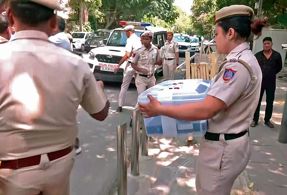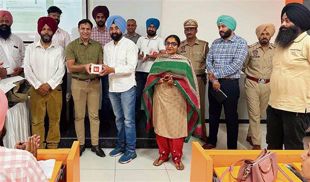
Youth Congress activists agitating against the rising prices of pulses in Nagpur. PTI
Rajkamal Mann
WITH the expansion of the area under rice and wheat, consequently, the area under pulses in Punjab has been declining since the year 1966-67. The efforts made for diversification have met with limited success. India produces more rice and wheat then the quantity it needs and less pulses compared to the quantity it needs. The production of pulses in India is estimated at 17.2 million tonne, whereas the requirement of pulses is about 22 million tonne. There is a gap of approximately 5 million tonne between demand and supply.
In the year 2015-16 (from April to July), 1.34 million tonne of pulses, worth Rs 6,132 crore ($0.93billion), have already been imported. Last year, 4.7 million tonne of pulses worth Rs 17,461 crore ($2.87 billion) were imported in India. To control the rising prices of pulses, the government had already floated tenders for the import of 10,000 tonne. Imports have been made duty free for another year and stock limit has been imposed.
A look at the data of crop production in Punjab reveals startling facts. From the year 1966-67 onwards, there has been a continuous increase in the area under rice and wheat cultivation and a simultaneous decrease in the area under pulses. The highest area (63,000 hectares) and production of pulses (530,000 tonne) in Punjab was recorded in the year 1966-67. The area has now come down to 45,000 hectares, which is 93 per cent less than the area under pulses in the year 1966-67. The production of pulses declined to 39,000 tonne in the year 2013-14, which is less by 92 per cent than that recorded in the year 1966-67.
The lowest area under wheat in Punjab was recorded in the year 1966-67 was 1,615 thousand hectares. It increased by 117 per cent, to reach the figure of 3,512 thousand hectares in the year 2013-14. Likewise, the lowest area of 285 thousand hectares under rice was recorded in 1966-67, which in the year 2013-14 had reached to 2,851 thousand hectares, thereby showing an increase of 900 per cent.
The highest production of wheat was recorded in the year 2013-14, and for rice in the year 2012-13 — which was 17,620 thousand tonne and 11,267 thousand tonne, respectively. India is the biggest producer as well as importer of pulses in the world but ironically, it also imports a huge quantity of pulses to meet the domestic demand-supply gap.
To meet the domestic demand of pulses, 4758 thousand tonne of pulses were imported during the year 2014-15. This is 49 per cent more than the quantity of 3,178 thousand tonne imported in year 2013-14. Canada, Myanmar, Australia, the USA and Russia are the top five countries that export pulses to India. According to estimates, to fulfil the domestic demand requirement of pulses, the imports can touch the figure of 5 million tonne during the current year.
This is the right time for Punjab to take steps towards increasing the area under cultivation of pulses in Punjab. If Canada, Myanmar, Australia, the United States of America, and Russia can produce and send pulses to India, then why not Punjab? The state can also produce pulses to meet the domestic requirement of the country. The prices of cotton and basmati, which were promoted for diversification in Punjab, depend on the overseas demand. For both these crops, farmers receive a premium price only if there is a strong overseas demand. Because the overseas demand for both these crops has declined, that is why since the last few years these two crops have not given good income to farmers.
During the years 2010-11, 2011-12, 2012-13, 2013-14 and 2014-15 — out of the total pulses consumed in India, 13 per cent (2,777 thousand tonne), 17 per cent (3,495 thousand tonne), 18 per cent (4,019 thousand tonne), 14 per cent (3,018 thousand tonne) and 21per cent (4,758 thousand tonne) was met through imports.
It is, therefore clear that the domestic demand of pulses is much more assured than the overseas demand of cotton and basmati. This is the one of the major reasons why the prices of pulses have increased this year.
Although the MSP for pulses is more than double than that of rice and wheat, farmers do not prefer to grow pulses. There are three major reason for this reluctance to grow pulses.
The first and foremost reason is that the per acre yield of pulses is less than that of rice and wheat. The second factor is the uncertainty of the yield of pulses due to either insect or pest attack and the third reason is the absence of proper infrastructure for the marketing of pulses. The first two reasons by themselves make pulses less profitable for farmers and the third reason further adds to their problems.
To motivate the farmers to cultivate pulses, there is a need to make the income from pulses at par with that of rice and wheat.
The value chain of pulses, from the farmers field till they reach the end consumer needs to be studied. After analysing this, the middlemen need to be reduced. The producer has to be brought near the consumer. The previous data on the production of pulses can be seen and clusters for pulses production can be formed. In order to promote the production of pulses, these clusters must be linked to the market.
From the year 2010-11 to 2014-15, pulses worth Rs 58,816 crore ($10.68 billion) were imported. Out of these, pulses worth Rs 48,550 crore (82 per cent) were imported from Canada, Australia, the United States of America, Russia and Myanmar. Punjab can earn a substantial share of this amount which goes out of the country by promoting the production of pulses. This will benifit both the state and the nation.
The writer is a Young Professional with Niti Aayog. The views expressed are personal.



























